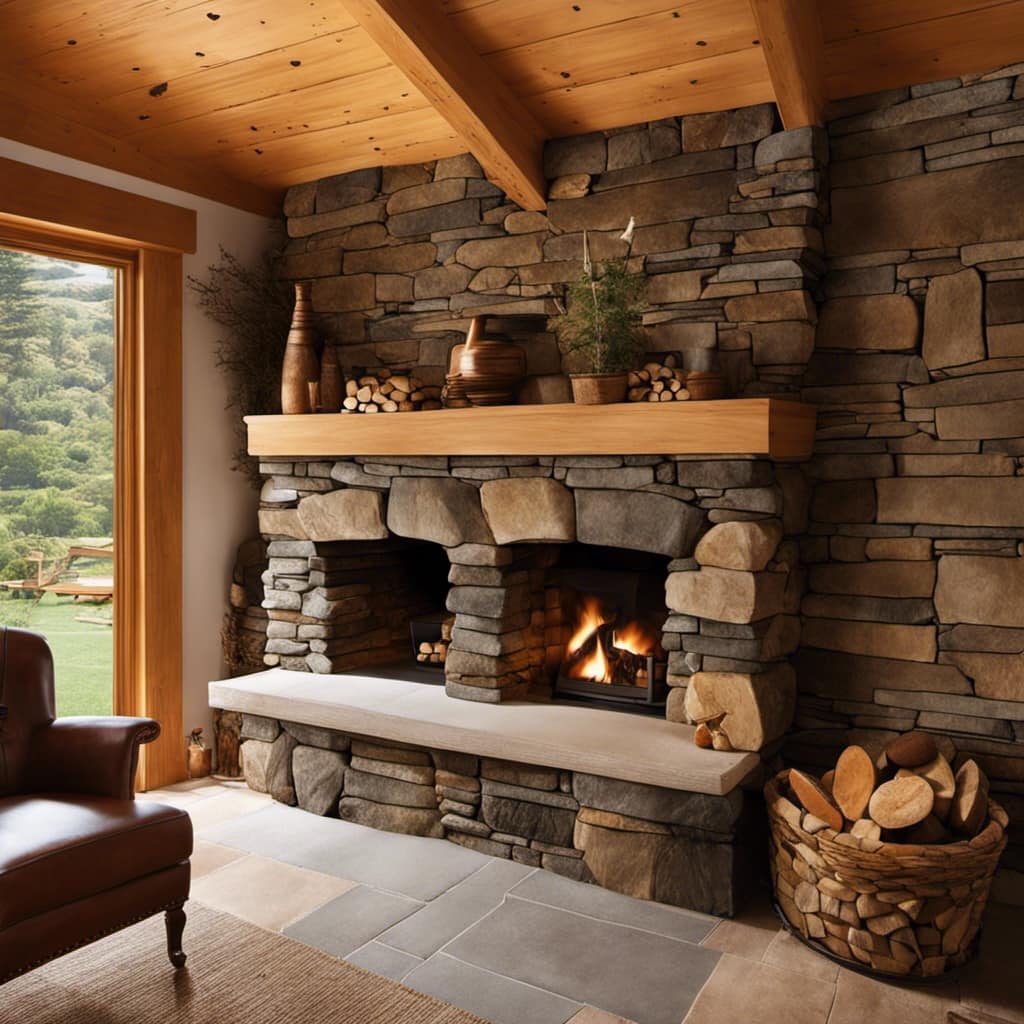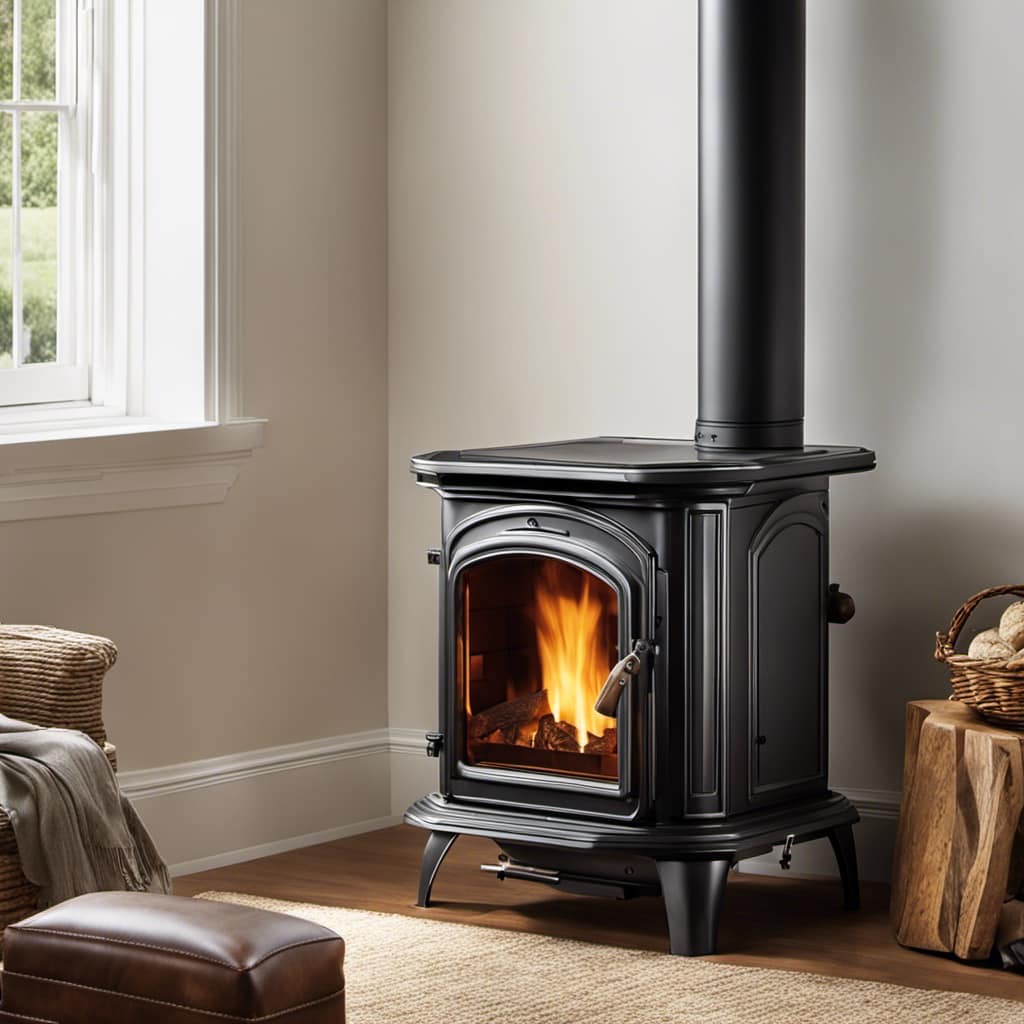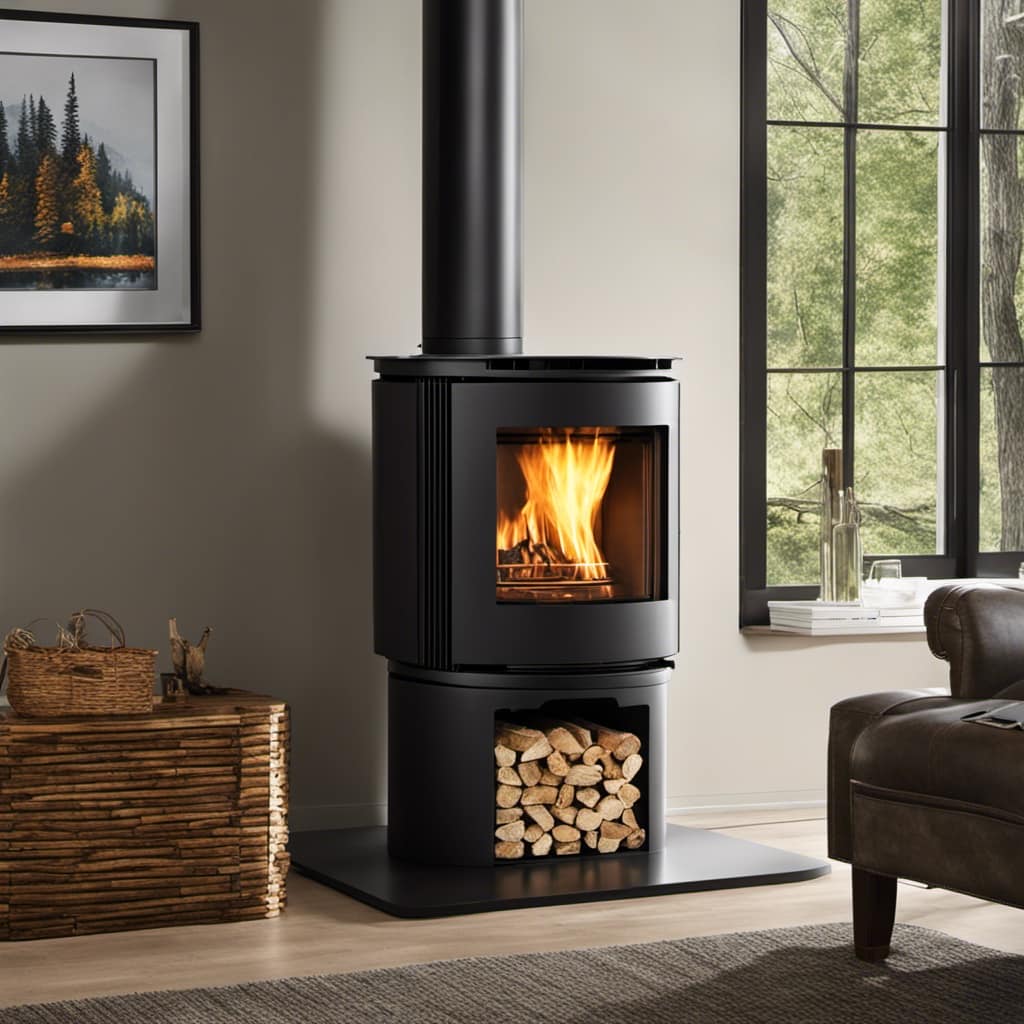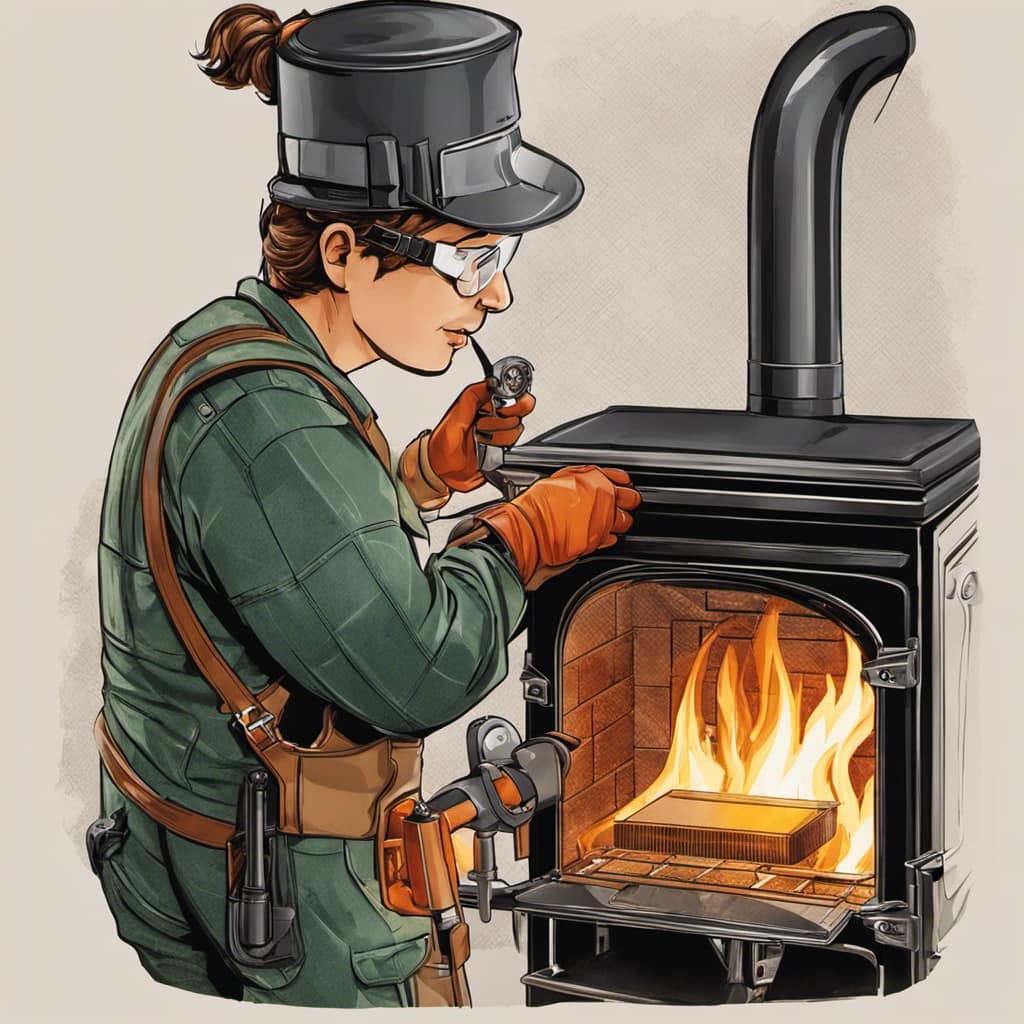You might be wondering – wood stoves create a cozy and soothing ambiance, but is it true that they emit harmful greenhouse gases (GHGs)?
Well, let me shed some light on the subject. In this article, we’ll explore the truth behind wood stove emissions and their impact on the environment.
By understanding the factors that influence GHG emissions and adopting sustainable practices, we can minimize our carbon footprint and enjoy the warmth of our wood stoves guilt-free.
Key Takeaways
- Wood stove efficiency determines the environmental impact.
- Factors such as fuel type, stove age, installation, and maintenance influence GHG emissions of wood stoves.
- Sustainable wood sources significantly reduce GHG emissions by promoting responsible forestry practices and carbon offsetting.
- Best burning techniques and regular maintenance can help reduce the carbon footprint of wood stoves.
Understanding Greenhouse Gas Emissions From Wood Stoves
I’m learning about the greenhouse gas emissions from wood stoves. Wood stove efficiency plays a crucial role in determining the environmental impact.

When wood is burned in a stove, it releases carbon dioxide, methane, and other greenhouse gases into the atmosphere. The efficiency of a wood stove refers to how well it converts wood fuel into heat.
More efficient wood stoves burn wood more completely, resulting in lower emissions. Inefficient stoves, on the other hand, produce more smoke and release higher levels of pollutants. This not only contributes to poor air quality but also increases the greenhouse gas emissions.
Therefore, improving wood stove efficiency is essential in reducing the environmental impact and mitigating climate change.
Factors Influencing GHG Emissions of Wood Stoves
There are several factors that influence the emissions of greenhouse gases from wood stoves.

-
Fuel type: The type of wood used in a stove can greatly impact its emissions. Hardwoods like oak and maple tend to burn more efficiently and produce fewer emissions compared to softwoods like pine and spruce.
-
Stove efficiency: Older, inefficient stoves emit more greenhouse gases than modern, EPA-certified stoves. Incentivizing the use of efficient stoves can help reduce emissions.
-
Proper installation: Poorly installed or maintained stoves can lead to incomplete combustion and increased emissions. Following wood stove regulations regarding installation and maintenance is crucial for minimizing emissions.
-
Burning practices: Burning wet or green wood can result in higher emissions. Proper wood seasoning and using dry wood can help reduce emissions.

-
Air supply: A well-regulated air supply is essential for efficient combustion and reducing emissions. Adjusting the air intake controls can help optimize the burning process.
The Impact of Sustainable Wood Sources on GHG Emissions
Using sustainable wood sources can significantly reduce GHG emissions from the production and use of wood stoves. Sustainable forestry practices ensure that the wood used in the production of wood stoves comes from responsibly managed forests. These forests are carefully harvested, allowing for the regrowth of trees and the maintenance of biodiversity.
By sourcing wood from sustainably managed forests, carbon offsetting is achieved as trees absorb and store carbon dioxide from the atmosphere. Additionally, sustainable forestry practices minimize the need for long-distance transportation, reducing energy consumption and emissions associated with transport.
Moreover, using sustainably sourced wood encourages the adoption of cleaner burning technologies, such as efficient wood stoves or pellet stoves, further reducing GHG emissions.

Overall, sustainable wood sources play a crucial role in mitigating GHG emissions and promoting environmentally friendly wood stove use.
Minimizing GHG Emissions: Best Burning Techniques for Wood Stoves
The best way to minimize GHG emissions from wood stoves is by using the most efficient burning techniques. This not only reduces the environmental impact but also ensures better indoor air quality. Here are some key factors to consider:
-
Use the best fuel: Choosing dry, seasoned wood with low moisture content can significantly reduce emissions. Wet or green wood produces more smoke and pollutants.
-
Proper ventilation: Ensuring adequate airflow in the room is crucial. Properly designed and installed flue systems can facilitate the efficient combustion of wood, reducing emissions.

-
Regular maintenance: Keeping your wood stove clean and well-maintained improves its efficiency and reduces emissions. Regularly inspect and clean the chimney to prevent blockages.
-
Optimal burning practices: Building small, hot fires instead of large, smoldering ones can reduce emissions. Use the damper to control the airflow and burn wood at a steady rate.
-
Upgrade to a certified stove: Consider investing in a modern, EPA-certified wood stove. These stoves are designed to burn wood more efficiently, resulting in lower GHG emissions.
Taking Action: Reducing Your Wood Stove’s Carbon Footprint
I can reduce my wood stove’s carbon footprint by implementing eco-friendly practices. Regular wood stove maintenance and exploring alternative heating options are two effective ways to accomplish this. By properly maintaining my wood stove, such as cleaning the flue and chimney regularly and ensuring proper airflow, I can improve its efficiency and reduce emissions. Additionally, using dry and seasoned firewood can also minimize the release of harmful pollutants. Exploring alternative heating options, like pellet stoves or high-efficiency wood stoves, can further reduce my wood stove’s carbon footprint. These options burn fuel more efficiently, resulting in lower emissions. By adopting these practices and considering alternative heating options, I can make a positive impact on the environment while still enjoying the warmth of my wood stove.

| Wood Stove Maintenance | Alternative Heating Options |
|---|---|
| Regularly clean flue and chimney | Install a pellet stove |
| Ensure proper airflow | Use a high-efficiency wood stove |
| Use dry and seasoned firewood | Consider geothermal heating |
| Perform annual inspections | Install a heat pump |
Frequently Asked Questions
Can Burning Wood in a Stove Contribute to Air Pollution?
Yes, burning wood in a stove can contribute to air pollution. It releases pollutants like particulate matter, carbon monoxide, and volatile organic compounds, which can harm air quality and have negative environmental impacts.
Are Wood Stoves a Cost-Effective Heating Option for Homes?
Wood stoves are a cost-effective heating option for homes due to their energy efficiency and long-term cost benefits. However, it’s important to consider the amount of GHG emissions they emit for a comprehensive evaluation.
What Are the Potential Health Risks Associated With Using a Wood Stove?
Potential health risks associated with using a wood stove include exposure to harmful pollutants like particulate matter and carbon monoxide. These pollutants can worsen respiratory conditions and cause cardiovascular problems. Wood stoves contribute to air pollution, which affects both indoor and outdoor air quality.
How Does the Type of Wood Used in a Wood Stove Impact GHG Emissions?
When it comes to the impact of wood moisture on GHG emissions and the comparison of emissions from different types of wood, it is important to consider the type of wood used in a wood stove.

Are There Any Government Regulations or Incentives to Encourage the Use of Low-Emission Wood Stoves?
Government regulations and financial incentives play a crucial role in encouraging the use of low-emission wood stoves. These measures aim to reduce greenhouse gas emissions and promote sustainable heating options for households.
Conclusion
In conclusion, wood stoves emit greenhouse gases (GHGs) which contribute to climate change. However, by understanding the factors that influence GHG emissions, using sustainable wood sources, and implementing best burning techniques, we can minimize the carbon footprint of wood stoves.
It’s crucial that we take action to reduce GHG emissions from wood stoves to mitigate the effects of climate change. Together, we can make a positive impact on the environment.
Growing up surrounded by the vast beauty of nature, Sierra was always drawn to the call of the wild. While others sought the comfort of the familiar, she ventured out, embracing the unpredictable and finding stories in the heartbeat of nature.
At the epicenter of every remarkable venture lies a dynamic team—a fusion of diverse talents, visions, and passions. The essence of Best Small Wood Stoves is crafted and refined by such a trio: Sierra, Logan, and Terra. Their collective expertise has transformed the platform into a leading authority on small wood stoves, radiating warmth and knowledge in equal measure.











